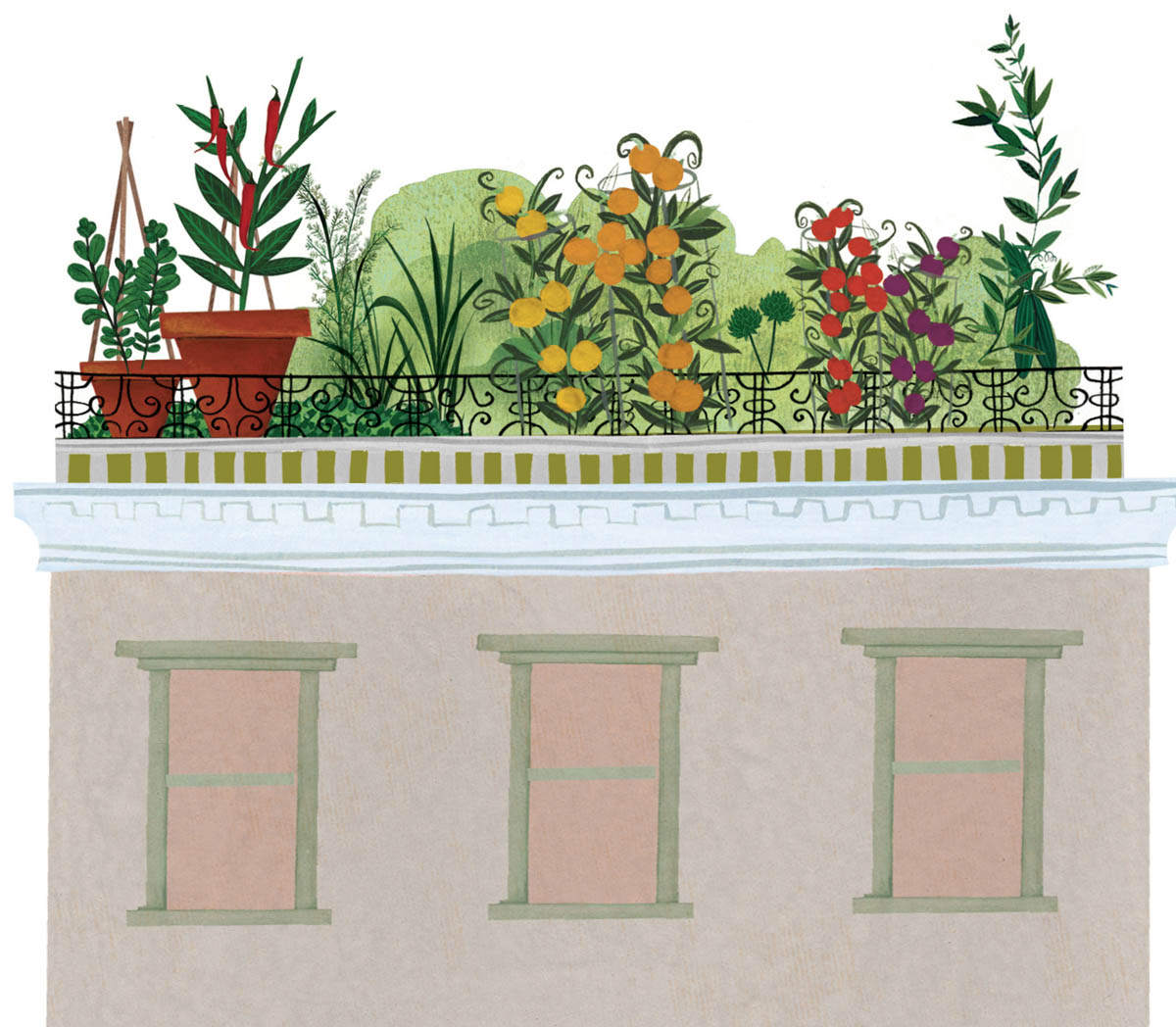
In urban areas with little open land, gardeners are turning to rooftops to grow food. Colin McCrate and Hilary Dahl have transformed a barren rooftop into an urban oasis with room for a variety of potted and raised-bed crops, as well as a pergola-covered seating area topped by a hops vine.
The folks at the Seattle Urban Farm Company, founded by Colin McCrate and Brad Halm, want to see more rooftops put into food production. “Rooftops are an incredibly underutilized resource,” says Colin. “Creating food-producing green spaces seems like a great way to get more value from our urban land.” He cites many benefits of rooftop farming, including reducing storm water runoff, lowering energy bills, and cooling the environment. A big benefit is the satisfaction of creating a space that is relaxing yet able to produce a surprisingly large volume of food. “Whether it is a community garden on an apartment building, a production garden for a restaurant, or a market garden, thousands of pounds of produce can be grown right above our homes and offices,” he says.

Overcoming difficult conditions.Gardening on an exposed rooftop does offer its share of challenges, however. “Rooftops can be much windier and have more extreme temperatures (hotter and colder) than at ground level,” warns Colin. Because containers and beds have limited soil depth on rooftops, the soil needs to be consistently amended with high-quality composts and fertilizers. Colin also notes that it is easy to over- or underfertilize crops in containers, and he recommends yearly pH and soil nutrient tests.
Planting in barrels. Colin and Hilary have included nine half-barrel planters for edibles and annual flowers, as well as six cedar-framed raised beds measuring 4 by 6 feet. They recommend that the beds be at least 10 to 12 inches deep to preserve moisture and make it easier to maintain adequate nutrient levels. The two dwarf fruit trees should also be planted in half-barrel planters or containers of a similar size. Columnar apples stay small with minimal pruning and thrive in containers.
To make the most of limited space, Colin recommends succession planting, amending the soil and sowing another crop as soon as the initial crop has been harvested. He advises adding a small amount of compost and organic fertilizers to each bed between crops and occasionally boosting crops with compost tea or a liquid organic fertilizer.
Lush sanctuary. Colin and Hilary’s plan was to grow edible crops, but also to create a small sanctuary in the middle of the city. They have included a cozy seating area, which is tucked in a corner of the garden under the shelter of a hop-covered pergola. “The hops are a deciduous vine and will provide a break from the heat in the summer, while allowing for a nice sunny spot during the cooler months,” says Colin.
Help for urban bees. A rooftop is also a great place for urban bees, and Colin and Hilary have included three hives in this plan. “Rooftops are out-of-the-way, sunny locations, so they provide an opportunity to increase the number of urban bees while keeping stinging hazards on ground level to a minimum,” Colin says. With the decline in bee populations, Colin says that many urbanites are setting up hives to help bolster the populations, with the bonus of collecting honey.

1. Assorted greens: ‘Deer Tongue’, ‘Nancy’, ‘Winter Density’, and ‘Breen’ lettuce; ‘Surrey’ and ‘Roquette’ arugula; ‘Calypso’ and ‘Santo’ cilantro
2. Beets: ‘Napoli’, ‘Scarlet Nantes’, and ‘Purple Haze’ carrots; ‘Early Wonder’, ‘Chioggia’, and ‘Touchstone Gold’
3. Onions: ‘Red Rezan’, ‘Polish White’, and ‘French Pink’ garlic; ‘Ailsa Craig’, ‘Prince’, and ‘Ruby Ring’
4. Perennial herbs: Italian oregano, ‘Aureum’ golden oregano, Greek oregano, common (English) or ‘French’ thyme, peppermint, and rosemary
5. Kale, broccoli, and Swiss chard: ‘Toscano’, ‘Rainbow Lacinato’, and ‘White Russian’ kale; ‘Bay Meadows’ and ‘Arcadia’ broccoli; ‘Bright Lights’ Swiss chard
6. Strawberries: ‘Seascape’
7. Hot peppers: ‘Thai Hot’, ‘Early Jalapeño’, ‘Ancho’, and ‘Fish’
8. Dwarf fruit trees: ‘North Pole’ and ‘Golden Sentinel’ columnar apples (need two different apple cultivars with corresponding blooming times to ensure pollination)
9. Annual flowers: Good choices to support the bee population include calendulas and nasturtiums (edible flowers), anise hyssop (edible leaves), and sweet alyssum and lobelia (nonedible ornamentals)
10. Squash: ‘Zephyr’ and ‘Gentry’ summer squash; ‘Jackpot’ zucchini
11. Potatoes: ‘Yukon Gold’, ‘All Blue’, and ‘Colorado Rose’
12. Tomatoes: ‘Black Prince’, ‘Pineapple’, ‘Sungold’, ‘Black Cherry’, ‘San Marzano’, and ‘Brandywine’ (trellised)
13. Hops: ‘Cascade’, ‘Centennial’, or ‘Willamette’
14. Cucumbers: ‘Marketmore 76’, ‘Suyo Long’, and ‘Lemon’ (trellised)
15. Pole beans: ‘Fortex’ (trellised)